(See updates below the main article.)
Did a Simple Police Gazette Tweet Trigger the First BKB Title Defense in 128 Years?
World bare knuckle boxing champion Bobby Gunn will defend his title against challenger Shannon Ritch on November 17th in Canada. Access through Pay-per-view is planned.
After a series of disappointments over the past two years, it appears a match has finally been set and the Police Gazette championship belt for bare-knuckle boxing will be contested for the first time since 1889. The Police Gazette has authorized the Bare Knuckle Boxing Hall of Fame to administer the belt, and BKBHOF president Scott Burt said Monday in a video statement, “It can’t be a world-title fight unless the Holy Grail of all belts is on the line. We are going to put a big emphasis, a great big mark on this fight between Shannon Ritch and Bobby Gunn.”
So how did things come together so quickly after so much frustration in recent years? Chalk it up to two fighters who are just sick of waiting. But the spark seems to have been a routine tweet by the Police Gazette on October 20th. In it we posted a picture of the “Police Gazette Heavy-Weight Champion Prize Ring Belt of the World” as it appeared in 1894. Shannon Ritch, inspired to action by the image, later replied to our tweet and reported, “I have challenged Bobby Gunn to defend his bare knuckle title / he has accepted!! Waiting on venue and date! But it’s going to happen.” We quickly replied to Shannon, saying “We fully approve this match-up. The sooner the better!”
Three days later, activity heated up. On Monday morning Shannon issued a video challenge to Bobby Gunn in which he said “I want to test myself against the best. I know you’re the best. I will come to any place you say. You name the time and place. I will be there. Let’s get on this. Let’s toe the line.” That afternoon Bobby replied with a video of his own. He said “Fair play to you. You’ve already acknowledged when you challenge a man you have to go over to where that man is. Very soon you’ll be getting a time and location. I welcome your challenge with arms wide open, pal. You’re gonna get it, Shannon Ritch. You got the fight, pal. Let’s get it on now.” Later that day Bobby revealed a bit more regarding the date. “In about 1 month we will rock and roll.”
The exact rules will still need to be agreed upon. London Prize Ring rules, under which John L. Sullivan fought, allow stand-up grappling and throwing, though no attacking when a man is down and no striking with anything other than bare fists. But bare knuckle fighting in recent years has generally been closer to standard modern boxing, just without any hand coverings. The hands have to be completely bare.
On Tuesday evening, Bobby announced the fight will take place “in Canada on native land November 17th private invite-only non-disclosure event that will be streamed on Pay-per-view.” He added it would be “real BKB no hand wraps.” On Wednesday morning Shannon asked the Police Gazette “Are you on board with the fight between Gunn and myself? Will the Police Gazette sanction the title?” To which we replied “We’d approve this match if you fought underwater, as long as NO HAND COVERINGS. The rest is up to Bare Knuckle Boxing Hall of Fame.”
For his part, Scott Burt of the BKBHOF stated on Tuesday, “belt only on line if legal.” Last night Scott confirmed his position, saying he’s “just waiting to hear exact location so as to confirm it’s legality as it was when passed it to Gunn as a result of his 2011 fight.” On August 5, 2011, the Yavapai Nation just outside Scottsdale, Arizona, sanctioned a bare-knuckle bout between Bobby Gunn and Richard Stewart under the laws of the Nation. Bobby emerged the victor and claimed the bare-knuckle world championship. In 2014, the BKBHOF under Scott Burt sanctioned this claim by presenting Bobby with their championship belt. In February 2016, the Police Gazette under current publisher Steven Westlake authorized the BKBHOF belt as representing the Police Gazette championship, thus ending a nearly 124-year suspension of the Police Gazette belt signifying world bare knuckle champions. As the Police Gazette was the last organization to officially sanction world bare knuckle championships, this made Bobby Gunn the lineal BKB champion after John L. Sullivan. And now Shannon Ritch wants that title.
Shannon is confident everything is in order. Yesterday afternoon he reported “Big things cooking / just finished interview with Stayton Bonner with Rolling Stone Magazine! The super Fight is on!!” Watch for updates here as they develop.
 Today’s Police Gazette and BKBHOF world-championship belt in bare knuckle boxing.
Today’s Police Gazette and BKBHOF world-championship belt in bare knuckle boxing.
UPDATE 10/31: Bobby Gunn has announced Pay-per-view arrangements for the BKB world championship event on November 17th. The price is $9.99 before the date of the event. Those wishing to reserve theirs can go here.
UPDATE 10/29: Tempers are already flaring in the run-up to the November 17th super fight for the bare knuckle boxing world championship. On Friday challenger Shannon Ritch taunted champion Bobby Gunn, saying “enough talk – bobby just show up !man to man! You better not duck me!” To which Bobby replied “My pal, you can say all the insults you want I promise you as sure as the sun rises tomorrow morning you’re going to get what you ask for.” Shannon retorted “You better show up! No excuses! 100% healthy or injured you better show up.” But Shannon wasn’t done. He next turned his ire to Scott Burt and the Bare Knuckle Boxing Hall of Fame, which controls the issuance of the Police Gazette championship belt, the belt that signifies the lineal BKB champion after John L. Sullivan. Scott has said the fight needs to be considered legal in the jurisdiction in which it occurs. Shannon reacted to this uncertainty by first stating “I want the Victory! The win means more than a cheap belt!” But then got more personal, saying “So funny when someone thinks they are bigger than they are (Scott Burt) make me laugh! I’ve fought all over the world. Your organization (BKBHOF) is made up.” Scott replied with “No matter BKBHOF or Police Gazette agrees or disagrees w/folks opinions, we ALWAYS show respect. #Class.” Shannon then proceeded to argue his case over legality and the rules. “Guess if it’s on Indian reservation that will make it legal. Although John L Sullivan’s fights were illegal – hmmm.” And “Yes all john l Sullivan fights were illegal.. lol at BKBHOF.” Regarding the rules, Shannon pointed out that Sullivan’s BKB fights included stand-up grappling. “BKBHOF, your all about Sullivan! All his fights were grappling and boxing – R we going to have same rules? That’s right up my alley!” Scott has already announced the fight will be regular stand-up boxing with no wraps or coverings of any kind on the hands or arms. And there will be no rounds. But grappling is not included.
From our perspective, Shannon is correct that all of John L. Sullivan’s BKB fights were illegal at the time they took place and that they included stand-up grappling and throwing. As for the legality, when gloved boxing became legal in 1892, the Police Gazette suspended the use of its championship belt as representing BKB champions, and continued it as the emblem of gloved champions. Now, with BKB making a comeback, it was natural for us to reinstate the Police Gazette belt as the signifier of world BKB champions since the last time there was an official BKB world champion it was the Police Gazette that bestowed the title. Last year, we passed the management of this title to Scott Burt of the Bare Knuckle Boxing Hall of Fame in recognition of his immersion in the subject and the singular work he’s done in the field. The Police Gazette is many things, boxing being one of them. Outsourcing the boxing aspect to someone who is focused on that one thing will end up being better for everyone in the long run. We want to see action. And as we’ve already said to Shannon, the Police Gazette doesn’t care if you guys want to fight under water. But it would be better for the sport in the long run to have things be reasonably legal. As of today, Scott has received assurances and has no knowledge that the fight will NOT be legal. So as of now, all systems are go for the belt to be bestowed. As for the rules, our position is that the rules are whatever the two camps agree on as long as the fighting is stand up and there are no hand coverings of any kind.
UPDATE 10/27: Scott Burt announced the ground rules for the bout. It will be “A stand-up, toe-to-toe fight. Bare knuckle; not a speck of tape from your shoulder to the tip of your fingers. No rounds, unless there is TV viewing involved. Then we will alter the rules.” See his full video statement here.
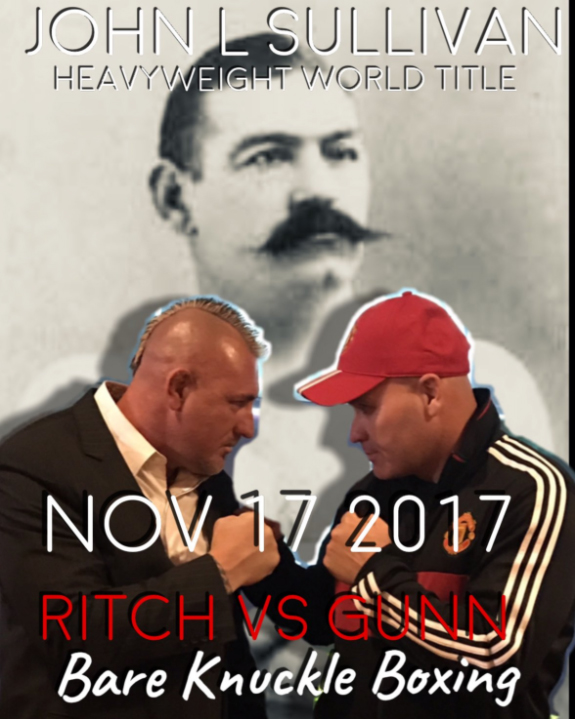

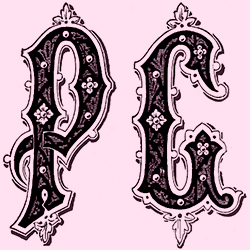


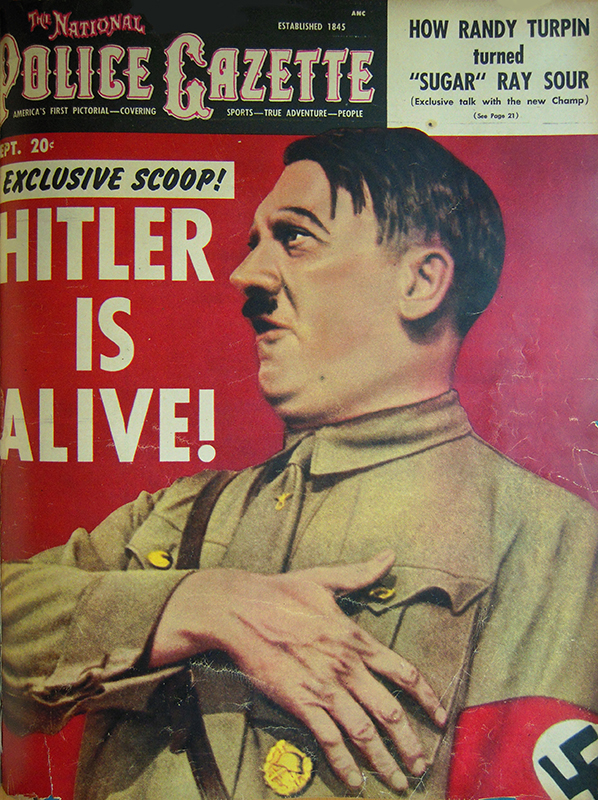 The first salvo in the Police Gazette’s “Hitler Is Alive” series appeared in the September 1951 issue.
The first salvo in the Police Gazette’s “Hitler Is Alive” series appeared in the September 1951 issue.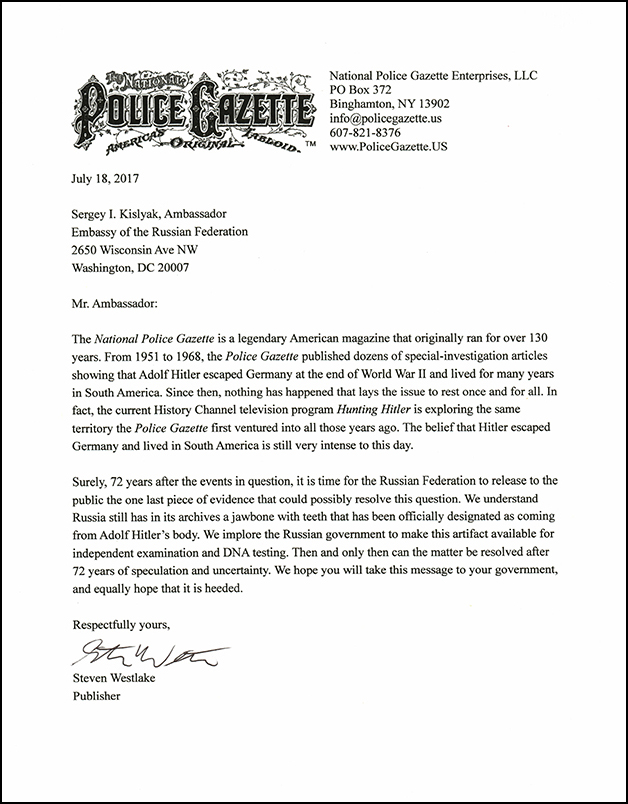 Our letter to the Russian embassy requesting release of the Hitler jawbone.
Our letter to the Russian embassy requesting release of the Hitler jawbone.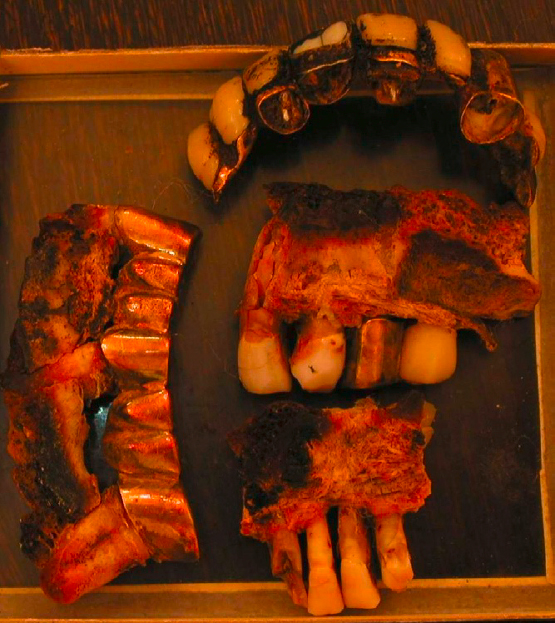 The items claimed by the Russians to be Hitler’s real teeth, jawbone, and false teeth.
The items claimed by the Russians to be Hitler’s real teeth, jawbone, and false teeth.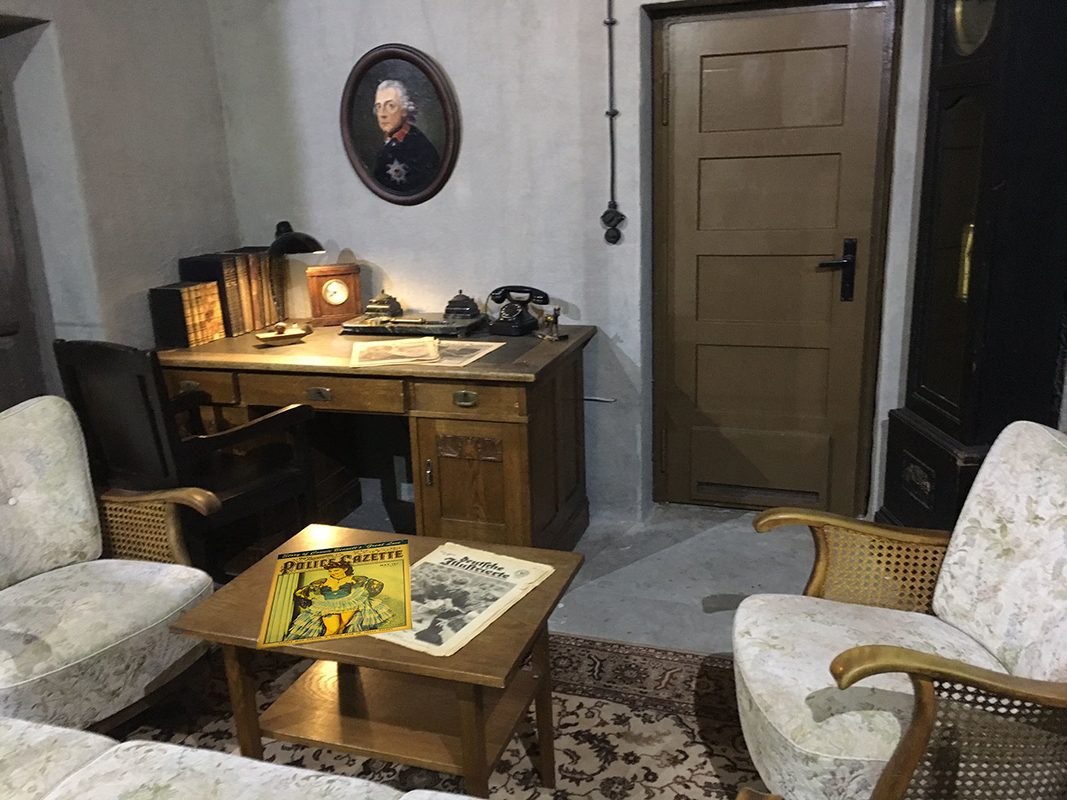 Hitler’s Führerbunker study almost exactly how it looked in April 1945.
Hitler’s Führerbunker study almost exactly how it looked in April 1945.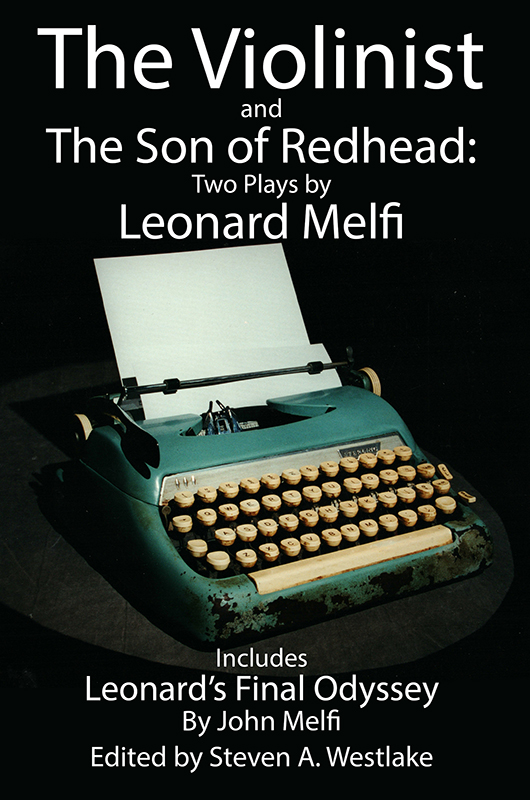
 Current Police Gazette publisher Steven Westlake, left, with Mitch Azaria, son of last Police Gazette publisher Joseph Azaria, at the transfer of the official magazine archive. Shown are about half of the total volumes.
Current Police Gazette publisher Steven Westlake, left, with Mitch Azaria, son of last Police Gazette publisher Joseph Azaria, at the transfer of the official magazine archive. Shown are about half of the total volumes. One of the first-day articles. The illustration is by publisher Westlake’s daughter, who now has even better artistic skills 10 years later.
One of the first-day articles. The illustration is by publisher Westlake’s daughter, who now has even better artistic skills 10 years later.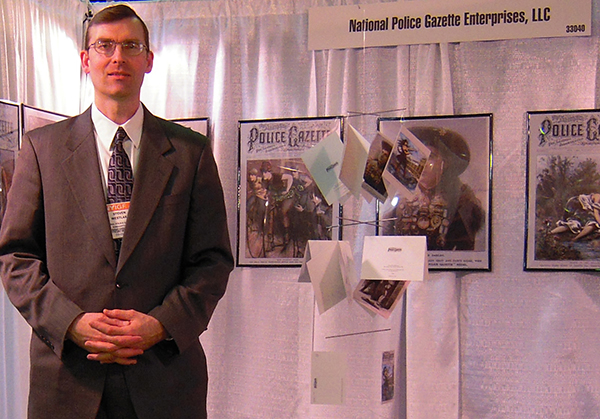 Publisher Westlake plying his trade at the NYIGF, Javits Center.
Publisher Westlake plying his trade at the NYIGF, Javits Center.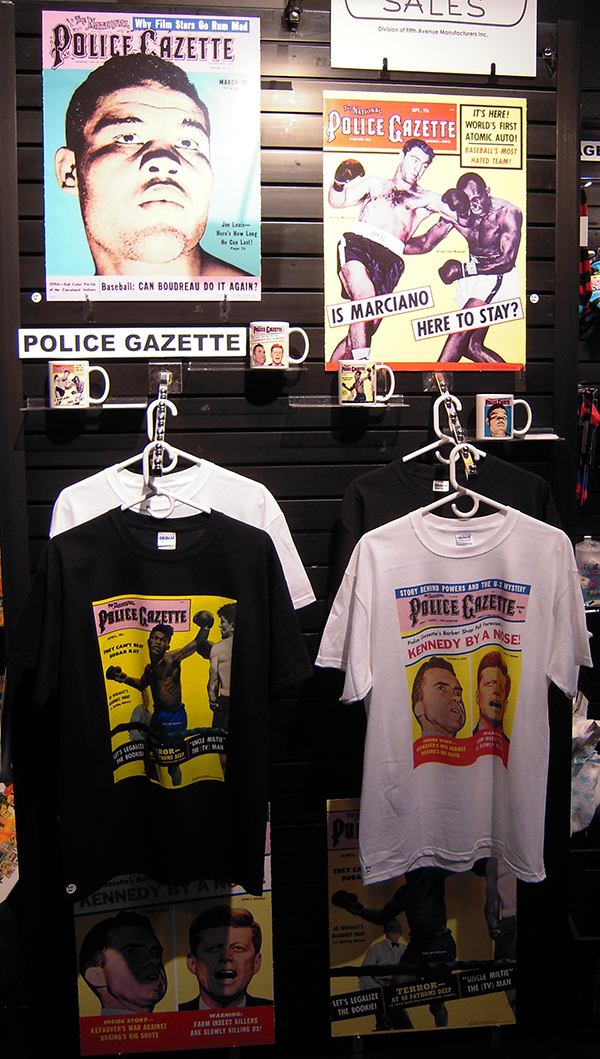 Our NYIGF Javits Center display the following year.
Our NYIGF Javits Center display the following year.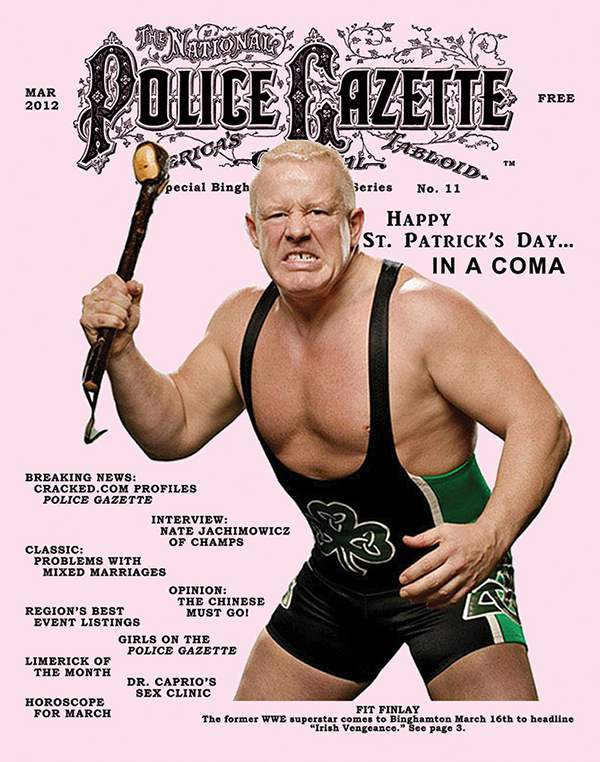 This print-edition cover features pro wrestler Fit Finlay ahead of his visit to Binghamton, NY. “Use the leg! Use the leg!” Those who were there know what we mean.
This print-edition cover features pro wrestler Fit Finlay ahead of his visit to Binghamton, NY. “Use the leg! Use the leg!” Those who were there know what we mean. Publisher Steve Westlake, left, with actor Gil Bellows who played 19th-century Police Gazette owner Richard K. Fox in the film Louis Cyr. Bellows holds our latest print edition.
Publisher Steve Westlake, left, with actor Gil Bellows who played 19th-century Police Gazette owner Richard K. Fox in the film Louis Cyr. Bellows holds our latest print edition.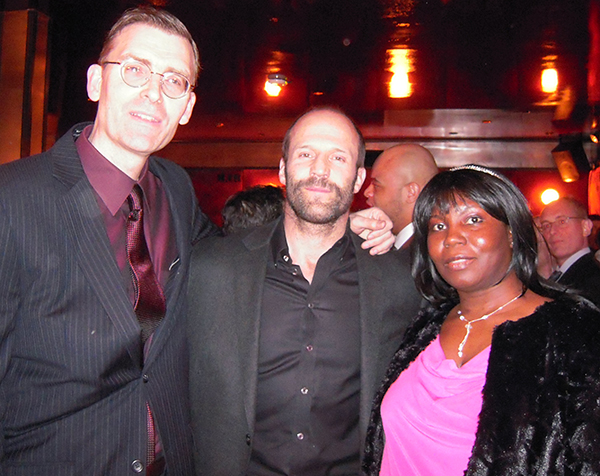 Publisher Westlake, left, and Police Gazette culture editor Judith Excellent flank Jason Statham at the premiere for his film Parker, based on the book written by Westlake’s father. Statham took a genuine interest in our print-edition article describing how Donald E. Westlake developed the Parker character.
Publisher Westlake, left, and Police Gazette culture editor Judith Excellent flank Jason Statham at the premiere for his film Parker, based on the book written by Westlake’s father. Statham took a genuine interest in our print-edition article describing how Donald E. Westlake developed the Parker character.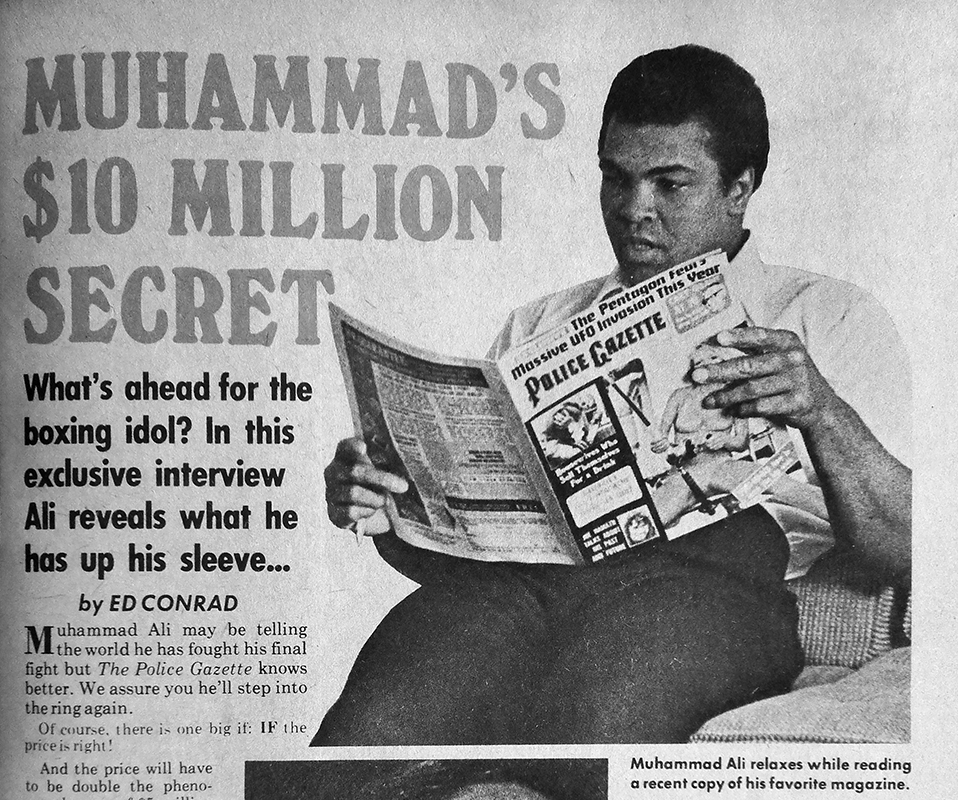 Muhammad Ali appears in the November 1974 Police Gazette. He is reading the August 1974 issue.
Muhammad Ali appears in the November 1974 Police Gazette. He is reading the August 1974 issue.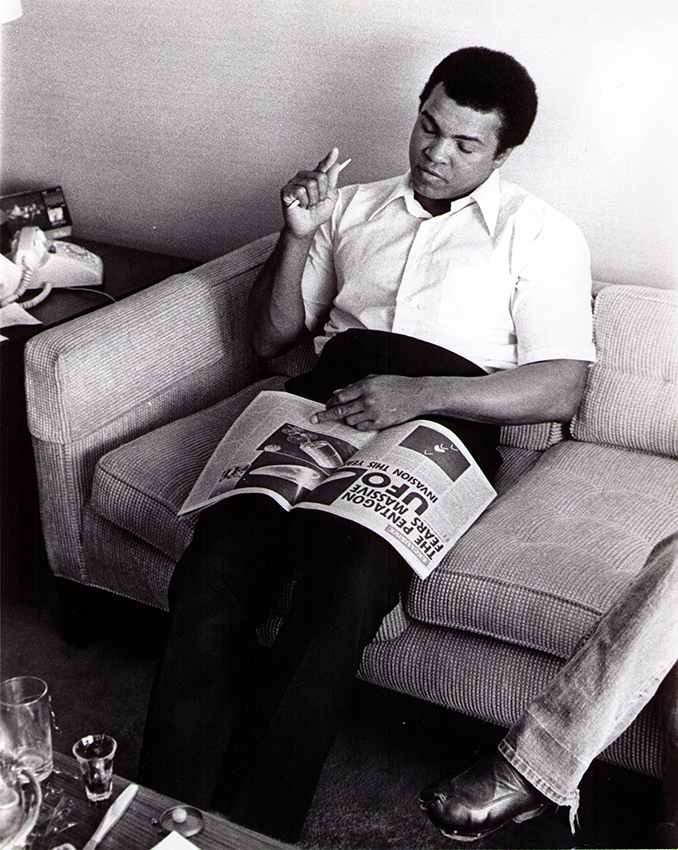 Photo-shoot outtake 1: Muhammad Ali reads the article about UFOs in the August 1974 issue. It’s unknown whose leg is in the lower right, but it is known two of publisher Joseph Azaria’s children accompanied the publisher and editor Nat Perlow during their meeting with Ali.
Photo-shoot outtake 1: Muhammad Ali reads the article about UFOs in the August 1974 issue. It’s unknown whose leg is in the lower right, but it is known two of publisher Joseph Azaria’s children accompanied the publisher and editor Nat Perlow during their meeting with Ali.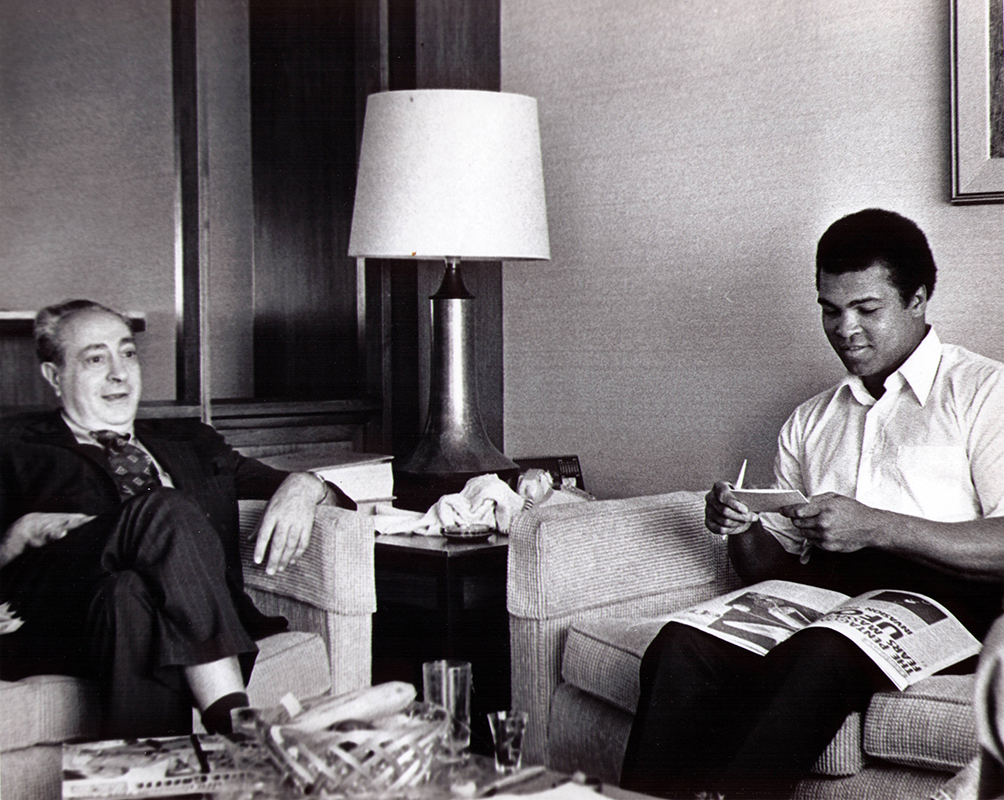 Photo-shoot outtake 2: Police Gazette editor Nat Perlow, left, and Muhammad Ali.
Photo-shoot outtake 2: Police Gazette editor Nat Perlow, left, and Muhammad Ali.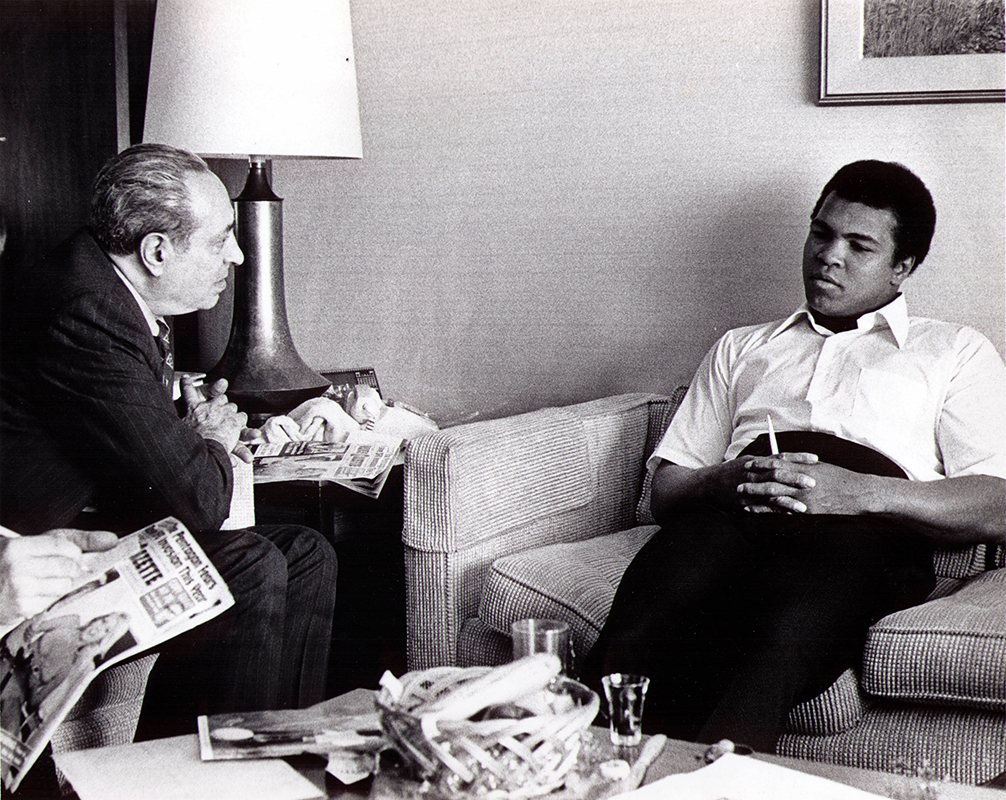 Photo-shoot outtake 3: Nat Perlow and Muhammad Ali. The hand holding the August 1974 issue at left may belong either to publisher Joseph Azaria or another staffer.
Photo-shoot outtake 3: Nat Perlow and Muhammad Ali. The hand holding the August 1974 issue at left may belong either to publisher Joseph Azaria or another staffer.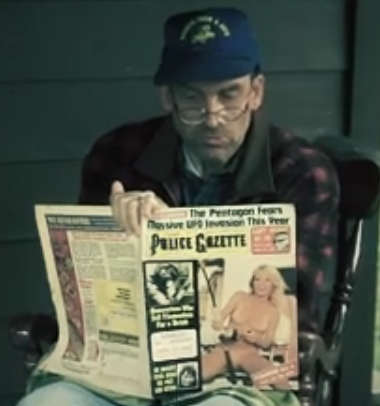 Current Police Gazette editor William A. Mays holds (coincidentally) the August 1974 issue in a scene from the new horror film
Current Police Gazette editor William A. Mays holds (coincidentally) the August 1974 issue in a scene from the new horror film 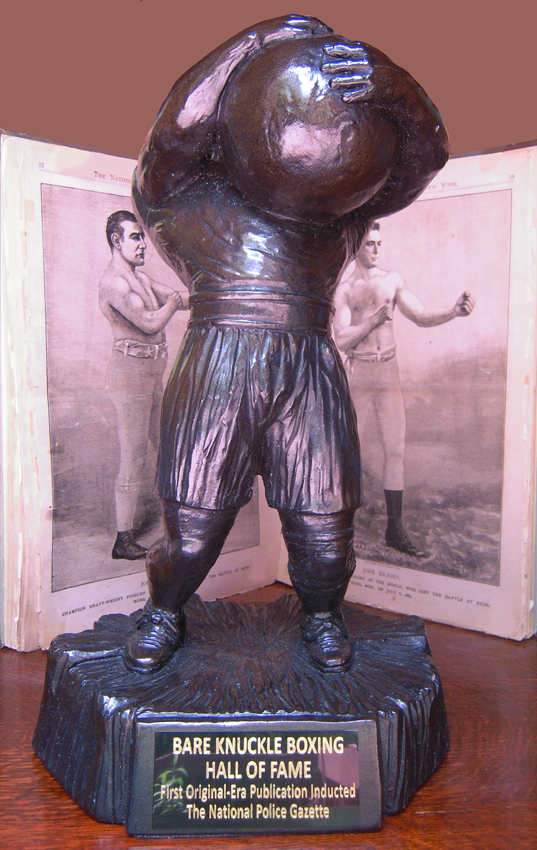
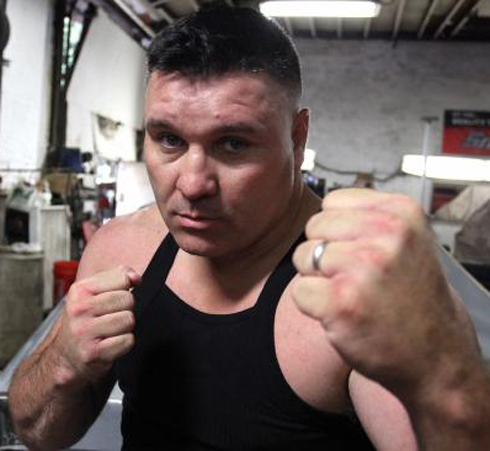 BOBBY GUNN; USA, Hackensack, New Jersey (71-0, 71 KOs)
BOBBY GUNN; USA, Hackensack, New Jersey (71-0, 71 KOs)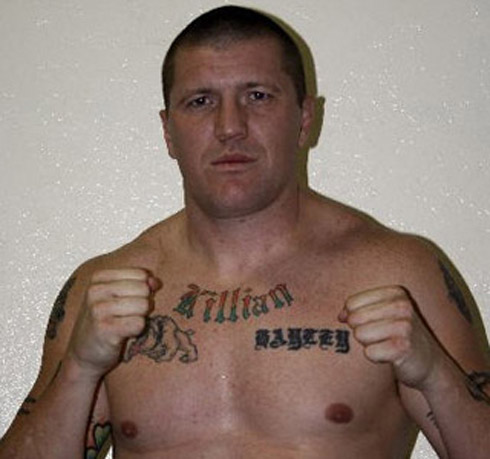 DANNY BATCHELDER; Glens Falls, New York (44-0, 44 KOs)
DANNY BATCHELDER; Glens Falls, New York (44-0, 44 KOs)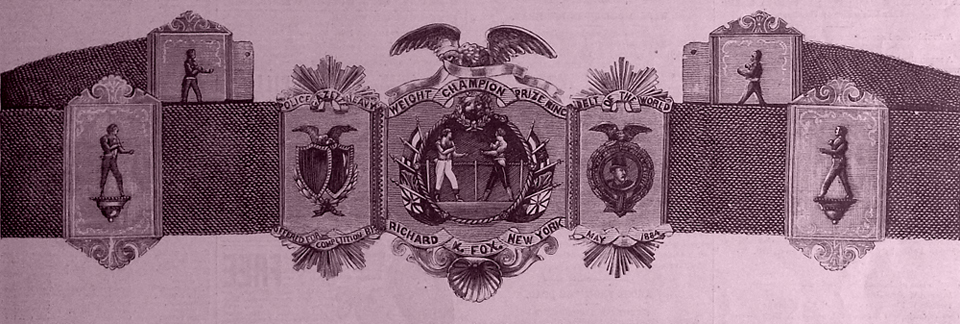 The Police Gazette Heavyweight Champion Belt
The Police Gazette Heavyweight Champion Belt Today’s Police Gazette World Champion Belt Presented by the Bare Knuckle Boxing Hall of Fame
Today’s Police Gazette World Champion Belt Presented by the Bare Knuckle Boxing Hall of Fame